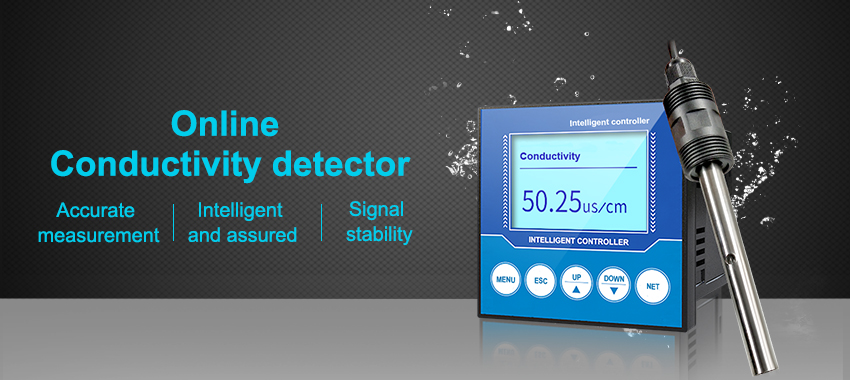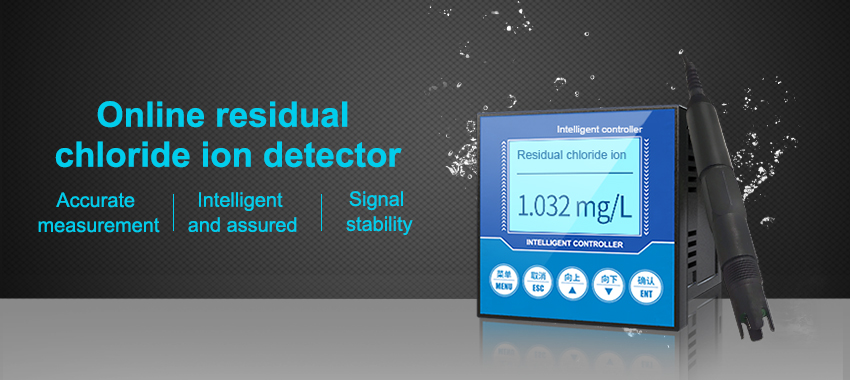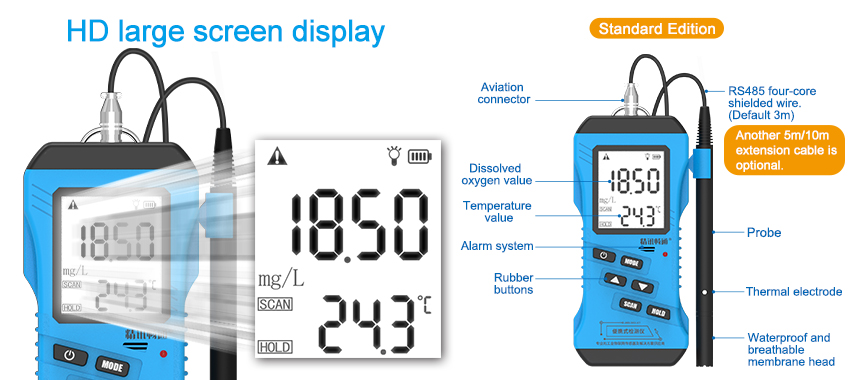Overview:
Water is the source of life, and human beings cannot do without water in life and production activities. The quality of drinking water is closely related to human health. Water quality monitoring and governance have become an important topic of modern science. The water quality online monitoring system can accurately, timely, and comprehensively reflect the current water quality and development trend, and provide a scientific basis for water treatment projects. The sensing front end of the water quality monitoring system is a water quality sensor.
water quality sensor:
The water quality sensor measures water parameters such as conductivity, dissolved oxygen, pH, COD, residual chlorine, and turbidity through a variety of methods such as water chemical, physical and biological reactions, and provides data support for researchers, observers, and engineers. It is used in laboratory research, environmental management improvement, marine water quality assessment, hydraulic model calibration, sewage treatment, and other fields.
What is a water quality sensor?
The water quality sensor is a general term for multiple sensors that measure PH, residual chlorine, turbidity, suspended solids, COD, BOD, conductivity, and dissolved oxygen. Water quality does not refer to a specific day parameter, it contains multiple elements to measure water conditions.
Types of water quality sensors
Water quality is a general concept, and it covers a wide range. Therefore, building a complete water quality monitoring system is a complicated project. The good news is that with these eleven Renke water quality sensors and a water quality monitoring host, you can easily build your water quality monitoring system.
PH Sensor
The PH value is an important indicator for monitoring industrial wastewater. In industrial wastewater, most microorganisms have an adaptation range of pH 4.5-9, and the most suitable pH range is 6.5-7.5. When the pH is lower than 6.5, the fungus starts to compete with the bacteria. When the pH reaches 4.5, the fungus will have a complete advantage in the biochemical tank, which will seriously affect the settlement of the sludge. When the pH exceeds 9, the metabolic rate of microorganisms will be hindered.
In order to monitor the PH value of industrial wastewater, we generally use PH sensors. The PH sensor is one of a water quality sensor used to monitor the concentration of hydrogen ions in the tested solution and convert it into a corresponding usable output signal. It is suitable for industrial sewage, domestic sewage, agriculture, aquaculture, and other scenarios in a non-corrosive weak acid and weak alkali environment.

Conductivity Sensor
Conductivity refers to the ability to conduct current in water. In water quality sensors, conductivity is one of the important indicators reflecting water quality. When the conductivity value of the water is higher, the conductivity is better, and the TDS value in the water is larger. The TDS value represents the content of dissolved impurities in the water. The larger the TDS value, the greater the impurity content in the water. On the contrary, the smaller the impurity content, the greater the water. Pure, the lower the conductivity.
Conductivity sensors can be divided into electrode-type conductivity sensors, inductive conductivity sensors, and ultrasonic conductivity sensors according to different measurement principles. Electrode type conductivity sensor adopts resistance measurement method according to electrolytic conduction principle. The inductive conductivity sensor realizes the measurement of liquid conductivity based on the principle of electromagnetic induction. Ultrasonic conductivity sensors measure conductivity according to the changes of ultrasonic waves in liquids, and the first two sensors are widely used.
EC sensor adopts electrode type conductivity measurement method, the built-in high-precision sensor is accurate, its conductivity measurement range is between 0~20000μS/cm, measurement error is ±1%FS, high sensitivity. This conductivity sensor comes with a cable connected to the transmitter, which sends the signal to the processing and/or recording equipment.

Residual Chlorine Sensor
Residual chlorine refers to the general term for free chlorine and combined chlorine remaining in the water after chlorinated disinfection and contact for a certain period of time. Residual chlorine is common in water quality sensors.
Turbidity Sensor
Turbidity is caused by suspended particles in the water. The suspended particles diffusely reflect the incident light. Usually, the scattered light in the direction of 90 degrees is used as the test signal. The scattered light and turbidity conform to a multi-segment linear relationship, so the sensor needs to be calibrated at multiple points.
The turbidity sensor is designed and manufactured using the principle of scattered light turbidity measurement. Accurately measure the amount of light passing through the water to accurately measure the suspended solids in the water, and these suspended solids can reflect the pollution of the water body. In this way, the turbidity in the water sample is measured, and the final value is output after linearization processing. It is often used in the accurate measurement of rivers, sewage, and wastewater by water quality detectors.

COD Sensor
Many organic substances dissolved in water absorb ultraviolet light. Therefore, by measuring the degree of absorption of 254nm wavelength ultraviolet light by these organic substances, the content of dissolved organic pollutants in water can be accurately measured.
The COD sensor uses two light sources, one ultraviolet light is used to measure the COD content in the water, the other reference light is used to measure the turbidity of the water body, and the light path attenuation is compensated by a specific algorithm and can be used to a certain extent. Eliminate the interference of particulate suspended matter impurities, so as to achieve more stable and reliable measurement.
Dissolved Oxygen Sensor
Dissolved oxygen sensor is one of water quality sensor for measuring the concentration of dissolved oxygen in a solution. It adopts the principle of fluorescence measurement. The fluorescent dissolved oxygen sensor is based on the quenching principle of active fluorescence by specific substances in physics, does not consume oxygen, and does not require electrolytes. It is divided into two types: seawater and freshwater.
It is suitable for scenarios where maintenance is inconvenient and requires long-term monitoring, such as industrial water quality monitoring, aquaculture monitoring, and river and lake seawater quality parameter monitoring.
Chlorophyll Sensor
The concentration of chlorophyll in the water reflects the content of phytoplankton. Monitoring the content of chlorophyll in the water can determine the eutrophication of the water. Chlorophyll sensor adopts the leading optical technology and has an automatic cleaning brush at the bottom for self-cleaning. All-in-one design with high-efficiency power management, robust construction and stable transmitter that does not require maintenance and frequent calibration. It can be measured in the environment for a long time.
Chlorophyll is one of the important components of algae, all algae contain chlorophyll a, and the level of chlorophyll a is related to the quality of the water environment. Therefore, the determination of chlorophyll a content in water can reflect the water quality. Algae and phytoplankton conditions in rivers, lakes, ponds, oceans and farming environments can be easily measured using chlorophyll sensors.
Blue-green Algae Sensor
Compared with the traditional manual counting method, the blue-green algae sensor adopts the principle of the fluorescence method, which is more efficient and fast, and can be monitored online in real-time. The sensor has better repeatability and stability. With an automatic cleaning brush, it can eliminate air bubbles and reduce the impact of contamination on the measurement. Long service life, use in harsh environments can maintain excellent stability. It can play an early warning role in the reproduction of algae.
Our blue-green algae sensors are widely used in water environment monitoring such as river sections, lakes and reservoirs, and near coasts. It is the best choice for monitoring phytoplankton, algal growth, water eutrophication, early warning of algal blooms, and studying water ecosystems.
Ion Probe Sensor
Ion probe sensor is a device that measures the concentration of various ions in water. There are eight types of ammonium ions, nitrites, nitrates, magnesium ions, sodium ions, potassium ions, chloride ions, and calcium ions.
Ion sensors are widely used in industrial wastewater, surface water, drinking water, seawater and ion on-line automatic continuous analysis and detection in industrial production process control. The ion concentration and temperature values of the aqueous solution are continuously monitored.
In conclusion
Water quality monitoring involves a wide range of fields, and different application sites need to monitor different parameters. For specific selection and operation, please contact us JXCT. We have professional technicians to provide you with the best matching program.